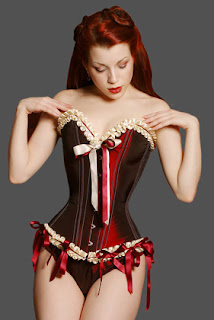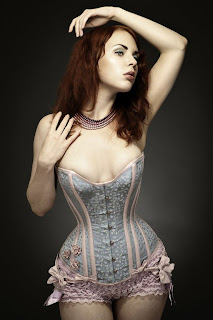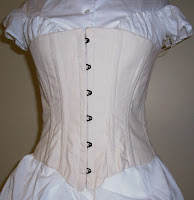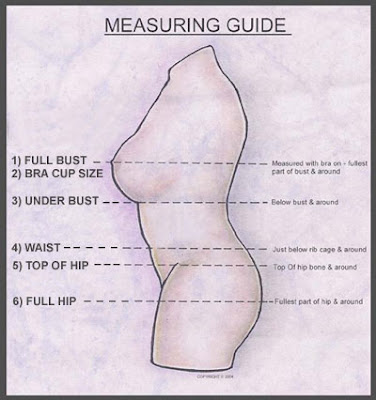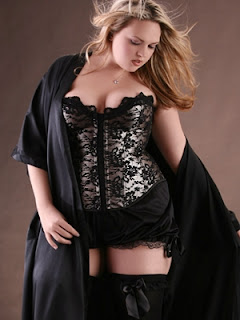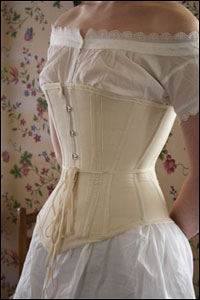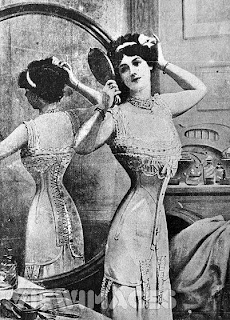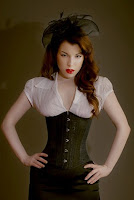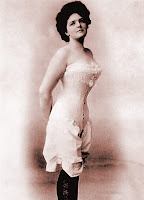“To put on a corset properly is as much of an art as to make a corset properly.” – Anna Held
In The Corset Guide: Part I, we learned a little bit of the history of corsets, why women wear them today, the dissection of a corset, and the different styles available today. In The Corset Guide: Part II, we learned how to choose the right corset for you, how to be measured, and advice for plus size corsetry. Today’s third part of The Corset Guide, we will learn the art of tight lacing, how to breathe, drink and eat in a corset, and ways to accessorize your corsetry look.
The most frequent aim of tightlacing is a slim waist. Depending on the silhouette desired, the shape of the ribcage may be altered as well. Wearing a corset can also change the bustline, by raising the breasts upwards and shaping them, flattening the stomach, and improving posture. However, these effects are only temporary and will be lost on removing the corset. Indeed, excessive corset wearing has been claimed to weaken certain muscles, making it more difficult to maintain posture without a corset. Although some tightlacers aim to get their waists as small as possible, others prefer to reduce their waists to a certain point and go no further as they consider that proportion and aesthetics are more important than achieving the smallest possible measurement. For example, cross-dressing males may seek to make a more feminine-appearing waistline through tightlacing, but do not want to make their waists too small, as this would look unnatural. Tightlacers typically wear a corset for at least 12 hours a day, every day, when they are most active, although more serious tightlacers (particularly those trying to achieve the smallest waist they can) wear corsets for up to 23 hours a day, taking the corset off only in order to bathe. Tightlacers sometimes have a partner, called a trainer, to help and support them. However, it is possible for somebody to tightlace without a partner.
In my case, I’m not an extremist. I can’t go to those extremes because of my disability. My natural waist fluctuates between 26 and 29 inches. As a tightlacer, I go down to about 22 inches, sometimes a little smaller. I don’t have the major side affects that other tightlacers do, such as the shape of my body becoming altered on a permanent level.
Prolonged tightlacers find that their ribs become narrower, tummy fat is shifted downward to the pelvic region, and even internal organs move into different positions. While I never judge what people do to their bodies, I personally cannot do that to myself. I have a hard enough time keeping my body in good condition. A tightlacer has to be healthy and in strong physical condition.
Do not attempt tight lacing if you have heart problems, breathing problems, blood flow problems, or anything else that might cause fatigue or weakness, as this process will intensify any weakness in the body.
From http://corsetinformation.com regarding the art of tight lacing.
Things to Do
- Wear an undershirt (cotton) or corset liner under the corset
- Moisturize the skin and make sure there are no dry spots. Red skin is a sign of dry skin
- After putting the corset on, pull the laces snug, not tight and straighten out the shirt or tube underneath. Reach behind you and run your fingers under the eyelet edges and lift the corset away from the skin a bit, while straightening the shirt or tube with the other hand. Settle the corset again, twist and bend and snug up the laces.
- Hook the laces around a doorknob or hook, walk forward until taut and even out the left and right laces, working any uneveness towards the top. Then tighten by pulling the lace crosses bottom to center, center to top with the excess on top evening the two laces out, and then pull the crosses top to center again.
- Keep the two sides evenly spaced top to bottom, and avoid a bulging gap at waist.
- Make several tours or runs when lacing, only take 1/2″ at a time and resettle.
- Once it gets tighter, pause and relax. Walk around and after 10-15min, undo the laces, relax the laces just a little, resettle and go again. After another two or three tours the corset will be on much tighter than before. Repeat this after another 20min or so. If you plan to tight lace, allow an hour, unless you are already wearing it 23/7, in which case you can probably go a little faster. For a special night out, an hour is a good number if you plan to wear it very tight. It will be much more comfortable.
- Take your time when getting into your corset! If you don’t have time, start earlier!
- For figure training, the duration in the corset is much more important than the degree of tightness. In fact if you cannot keep yourself from lacing in to your tolerance limit, then relax it by 1/2″ or so once you are “done”, just so you can enjoy it, rather than feeling you are in a fight with your corset.
- Don’t eat large meals before or during! No fatty foods, lots of water, fruits and vegetables and fiber. The corset will keep your stomach small and you will not have trouble losing or maintaining weight. In the end you will likely be healthier and more energetic.
- Exercise daily. Work the back and stomach muscles, but don’t tone the sides too much as these may “fight” the corset. For an hourglass shape you want your sides to “cave in” as much as possible. For good cardiovascular health, walking is excellent and you do this can while tight-laced if you like. Watch the breathing. If it becomes labored, slow down to match your pace to your breathing capacity
- Wear your corset as often and as long as possible. Sleeping in the corset allows the body to adapt faster and settle into the corseted shape. Usually the corset is relaxed by one or two inches especially if your daytime reduction is greater than four inches.
- Proportion is far more important than absolute smallest dimensions: A slender 31-22-32″ Bust/Waist/Hip would be corseted to 31-20-32″, but would be less dramatic than a 38-28-40″ laced to 38-22-40″.
Things Not to Do
- If tightlacing or long term wear is intended, don’t wear the corset directly on the skin
- When a spot continues to itch, don’t “sit it through”, but take it off and oil the skin
- After putting the corset on, don’t just start pulling the laces at the waist, it may damage the corset (tear out eyelets) and it may bulge and pinch the skin in back
- When putting the laces around the doorknob, do not “run away” or let your full weight pull the laces! This will damage the corset and it will not be comfortable! If it only took 5 minutes to take in five or six inches, you probably went too fast!
- Don’t pinch the top and bottom and allow a bulge at the waist! This will curve the stays in back and spoil the corset line. It should be hollow in the back. In general the back should curve more inward than the front, but usually less so than the sides.If the top and bottom close and you can’t get the waist to close no matter what, the corset waist size is too small, and you’ll have to train down your waist first and leave some gap at the top and bottom.
- Don’t pull it in all at once and tie it off. It’s not going to be anywhere near as tight as it can be and it may wear out the corset faster due to uneven pressure.
- Don’t lace to the point of discomfort and then stop, slow down when you feel it is getting close and enjoy it. If you are in a hurry, aim for less reduction. Even if you have been able to lace down to a certain size, don’t assume that you can always lace down to that size, unless you have been consistently wearing the corset. After a few days off, you have to re-train some to regain the lost ground, before getting down to your smallest size again.
- If it does not go down to size, don’t force it, choose different clothing, something that’s less dependent on the corseted size.
- Don’t think that by over tightening you can speed up the training. You may in stead get your body to put up a revolt and produce aches and pains. A corset can and will improve your shape in a healthy manner, but only if sufficient time is allowed for.
- Don’t eat a big meal and then start tightlacing. No fatty foods, avoid carbonated drinks, mint, tea, coffee, spicy foods may irritate the spincter, and cause acid reflux
- Don’t do heavy exercise while tight-laced. Moderate it if you plan to work out while tight-laced. When very tight, your breathing capacity may be reduced, and you need to allow for more frequent but shallower breaths. Walking, hiking, muscle training are not an issue, but running is probably not a good idea. If you plan to do so, just leave the corset off.
- Don’t tight lace just for a few hours a day. If you only plan to occasionally wear it, moderate the reduction, probably two or three inches, four inches max.
- The smallest waist does not necessarily give the best figure. Shape and proportion are the most important.













